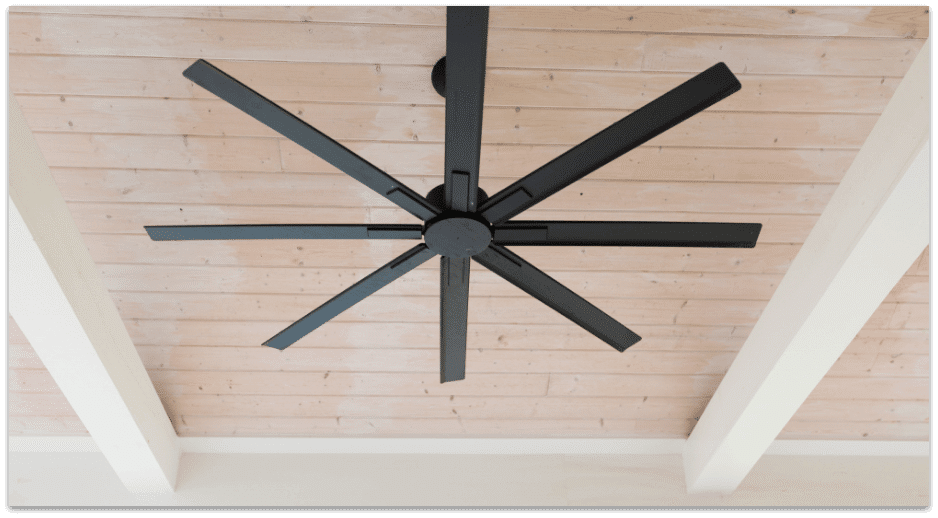5 Star Rated Local Electricians near Atlanta
There was a great sale at the local home improvement store and you just couldn’t resist! You’ve owned a beautiful new ceiling fan all summer long . . . only it’s been in a box on the garage floor and not hung where you and your family can enjoy it. You now realize you need an electrician for a ceiling fan installation. You would have hired an electrician months ago, but after a frustrating afternoon of calling everyone in the phone book, you had quotes ranging from $50 to $600, and no appointment.
You’re not alone! We get calls from homeowners every day who have “the perfect ceiling fan” but no way to install it in the Atlanta area. TE Certified is happy to help you with your ceiling fan installation.
Proper Installation Keeps Your Household Safe & Comfortable
The most important aspect of enjoying a ceiling fan is having it installed correctly. Ceiling fans that are poorly installed are unsafe or even dangerous. There are many aspects to a properly installed ceiling fan and calling an electrical company with questions about a fan may be confusing.
The following definitions can help:
Fan Box
Every ceiling fan needs an adequate support box (“fan-rated” and “UL Listed”). These are metal boxes that are installed in the ceiling in place of the plastic boxes that are used for lighter and stationary fixtures. Using anything other than a fan-rated box for a ceiling fan could result in stress on the plastic box and eventual collapse.
Angle Kit
This special adapter allows the safe installation of ceiling fans on even the most slanted ceilings.
Canopy
The decorative cone-shaped piece slides onto the down rod and hides the fan box, swivel, and wiring from view. An improperly installed canopy will result in an unfinished look to the fan and is a solid piece with a hole in the middle that must be slid onto the down rod prior to attaching the fan to the ceiling. The canopy is then slid back up into place and secured with small screws.
Down Rod
The rod extends from the ceiling (through the canopy) to the top of the ceiling fan. These rods come in many styles and finishes; they also come in different lengths. It is very important to purchase the correct Down Rod, especially on higher ceilings, so that the fan is circulating air where it can do the most good.
Down Rods are considered a part of the fan and should be selected when purchasing the fan so that they match perfectly. Ceiling fans of regular height (8’) usually are installed as close to the ceiling as possible and may only have a Down Rod that is several inches in length (which is included with the ceiling fan).
Light Kit
The Light Kit is often an optional element that can usually be added after the fan is installed. If your fan does not have a Light Kit, but you would like one, check to see if there is a small removable round plate where the light would go. Measure the diameter of this plate before heading to the store so you are sure to select the right kit for your fan.
Light kits can be as simple as a single glass bowl that covers the bulb or as elaborate as a multi-stemmed kit with decorative glass globes.
Pull Chain
The chain extends from the bottom of the fan. Some fans come with one Pull Chain (to change the fan speed) and some come with two (the second Pull Chain operates the light). The Pull Chains can be pre-set to the desired speed (or brightness) so that the Wall Switch will turn on the fan and/or light at the preset conditions.
If you have a fan that currently operates only on a Pull Chain, a new Wall Switch can be installed for the fan and light.
Wall Switch
A Wall Switch operates the fan independently of the Pull Chain. When the Wall Switch is in the “on” position, the Pull Chain settings can also be adjusted. A Wall Switch can be wired into a 2-gang box (a box with two switches) so that the fan and light are switched separately (the fan can be turned on without turning on the light and vice versa), or as a single switch (the Wall Switch turns on both the fan and the light at the preset conditions determined by the pull chain).
Remote
A separate device from the switch that operates the fan and/or light settings. A Remote can be added to a ceiling fan. The Remote has two parts: the Remote (the handheld device) and the Receiver (a device installed inside the fan).
Fan Mode Switch
An adjustable setting found on the fan itself (usually near the top, or base, of the fan). One direction allows for normal warm weather operation and the other setting reverses the fan direction for cooler months.
Switch Leg/Switch Line (SL)
The wiring that connects the ceiling fan to the Wall Switch. A SL is usually needed when a ceiling fan is installed from “scratch” (there is not current wiring in the ceiling), and should only be done by a licensed and qualified electrician with the proper tools to “run” or “fish” the wiring without extra holes or other drywall damage to the walls or ceiling.
Balancing Kit
A set of small self-stick or slide-on weights that come with the ceiling fan or can be purchased aftermarket. They are attached to the fan blades and are intended to “balance” fans that “wobble” or “shake” (i.e. incorrectly installed) fans. TE Certified Electricians avoid balancing kits. A properly installed ceiling fan should not wobble. If your fan motor and blades are installed professionally, no balancing is necessary. Most wobbling fans can be fixed by checking and securing all fan blades, tightening the fan's connections, and ensuring that the fan box is properly installed.
A ceiling fan installation should be completed by those thoroughly experienced in installing each of the above components. It is, after all, a major appliance suspended overhead! It is also important that the right tools are used for the job. This includes the right ladder. Many home accidents and poor installs happen when amateurs attempt to make installs or repairs without the right equipment.
The right height ladder will prevent stretching and reaching that could result in toppling the ladder (disaster). Toppled ladders result in damage to the person, walls, floor, and the fixture being installed. Being able to work with comfort and proper visibility allows for a good installation! If someone told you you’ll need scaffolding to replace your residential ceiling fan, they probably didn’t know what they were talking about. A good electrician should have the right ladders to safely install fans on ceilings up to 30 feet high.
TE Certified Electricians have installed thousands of ceiling fans and we know how to install them right. Plus, we warranty all our work for life, just in case there is a problem. So get that ceiling fan box off the garage floor and hung it where you can enjoy it . . . even if it is the end of Summer!
If you are interested in learning more about ceiling fan installation or have any questions, you are welcome to Schedule Now or call us at 770-667-6937. We would be more than happy to help in any way we can!













